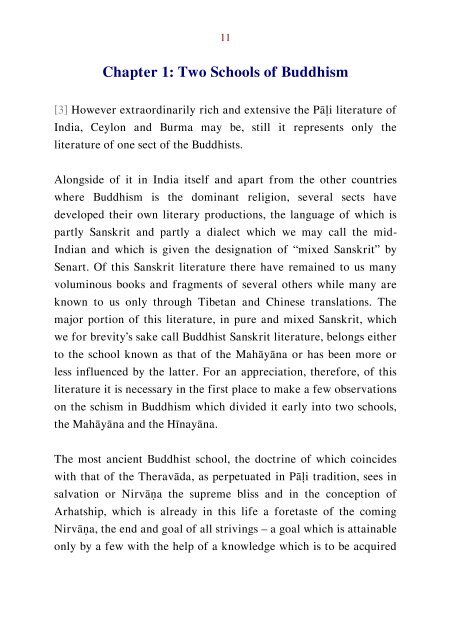Literary History of Sanskrit Buddhism
A study by J. K. Nariman of Sanskrit Buddhism from the Early Buddhist Tradition up to the Mahayana texts proper.
A study by J. K. Nariman of Sanskrit Buddhism from the Early Buddhist Tradition up to the Mahayana texts proper.
You also want an ePaper? Increase the reach of your titles
YUMPU automatically turns print PDFs into web optimized ePapers that Google loves.
11<br />
Chapter 1: Two Schools <strong>of</strong> <strong>Buddhism</strong><br />
[3] However extraordinarily rich and extensive the Pāḷi literature <strong>of</strong><br />
India, Ceylon and Burma may be, still it represents only the<br />
literature <strong>of</strong> one sect <strong>of</strong> the Buddhists.<br />
Alongside <strong>of</strong> it in India itself and apart from the other countries<br />
where <strong>Buddhism</strong> is the dominant religion, several sects have<br />
developed their own literary productions, the language <strong>of</strong> which is<br />
partly <strong>Sanskrit</strong> and partly a dialect which we may call the mid-<br />
Indian and which is given the designation <strong>of</strong> “mixed <strong>Sanskrit</strong>” by<br />
Senart. Of this <strong>Sanskrit</strong> literature there have remained to us many<br />
voluminous books and fragments <strong>of</strong> several others while many are<br />
known to us only through Tibetan and Chinese translations. The<br />
major portion <strong>of</strong> this literature, in pure and mixed <strong>Sanskrit</strong>, which<br />
we for brevity’s sake call Buddhist <strong>Sanskrit</strong> literature, belongs either<br />
to the school known as that <strong>of</strong> the Mahāyāna or has been more or<br />
less influenced by the latter. For an appreciation, therefore, <strong>of</strong> this<br />
literature it is necessary in the first place to make a few observations<br />
on the schism in <strong>Buddhism</strong> which divided it early into two schools,<br />
the Mahāyāna and the Hīnayāna.<br />
The most ancient Buddhist school, the doctrine <strong>of</strong> which coincides<br />
with that <strong>of</strong> the Theravāda, as perpetuated in Pāḷi tradition, sees in<br />
salvation or Nirvāṇa the supreme bliss and in the conception <strong>of</strong><br />
Arhatship, which is already in this life a foretaste <strong>of</strong> the coming<br />
Nirvāṇa, the end and goal <strong>of</strong> all strivings – a goal which is attainable<br />
only by a few with the help <strong>of</strong> a knowledge which is to be acquired


















